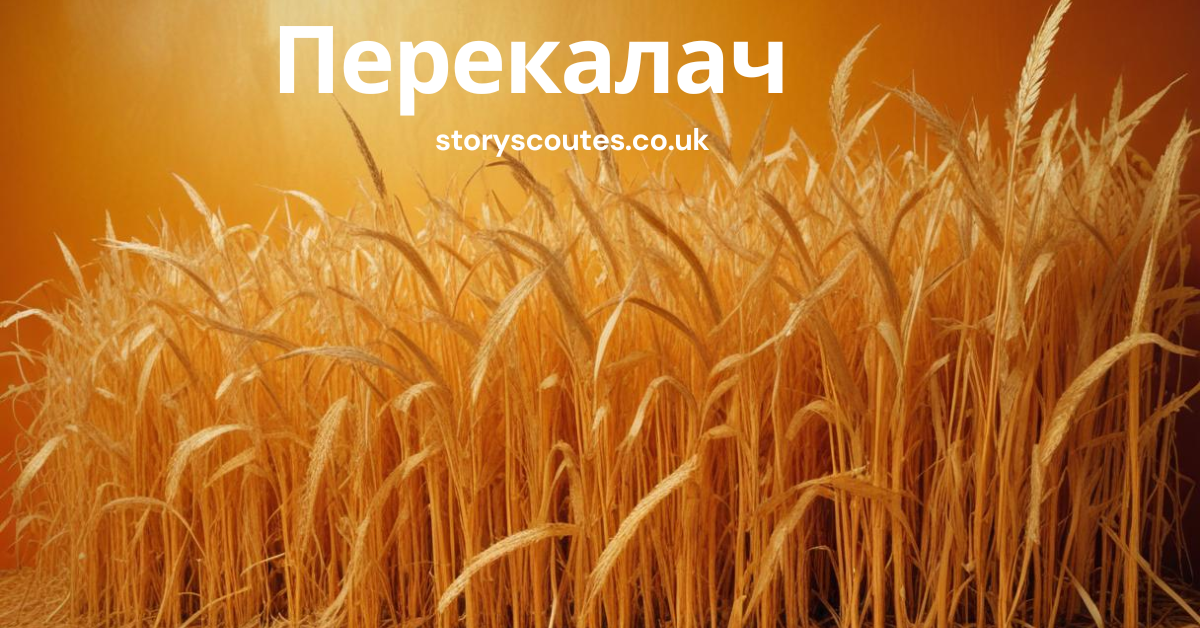Перекалач – The Ukrainian Bread of Life and Tradition
Bread has always been a cornerstone of Ukrainian culture, and among the many traditional breads, перекалач (pronounced “pere-kalach”) holds a special place. This ring-shaped bread is not just a food item but a symbol deeply woven into the fabric of Ukrainian society. In this comprehensive article, we’ll explore the rich history, cultural significance, and modern relevance of перекалач, offering insights that go beyond what you might find in typical online sources.
What is Перекалач?
Перекалач is a traditional Ukrainian bread shaped like a ring or wreath. Its name comes from the Ukrainian words “пере” (pere), meaning “over” or “across,” and “калач” (kalach), which refers to a type of round bread. This unique bread is more than just a culinary delight; it’s a cultural icon that has been part of Ukrainian life for centuries.
The Historical Roots of Перекалач
Ancient Origins
The history of перекалач dates back to pre-Christian times in Ukraine. Early Slavic peoples created ring-shaped breads as part of their pagan rituals, believing the circular form represented the sun and the cycle of life.
Christian Adoption
As Christianity spread through Ukraine, the church adopted and adapted many pagan customs. Перекалач found its place in Christian traditions, often used in wedding ceremonies and other important life events.
Symbol of Prosperity
Throughout history, перекалач has been seen as a symbol of prosperity. In times of hardship, the ability to bake this elaborate bread was a sign that a family had enough resources to celebrate and share with others.
The Cultural Significance of Перекалач
Wedding Traditions
One of the most important uses of перекалач is in Ukrainian wedding ceremonies. The bread is often placed on the table between the bride and groom, symbolizing their union and the joining of their families.
Harvest Celebrations
During harvest festivals, перекалач is baked to give thanks for a bountiful crop. The bread’s ring shape represents the cyclical nature of the agricultural year.
Religious Observances
In Ukrainian Orthodox and Catholic traditions, перекалач is sometimes used as part of religious offerings or placed on graves during All Souls’ Day to honor deceased loved ones.
Making Перекалач: A Labor of Love
Ingredients
The basic ingredients for перекалач include:
– Wheat flour
– Yeast
– Water
– Salt
– Sugar
– Eggs (optional)
– Milk (optional)
The Baking Process
1. Mixing the dough: The ingredients are combined to form a soft, pliable dough.
2. First rise: The dough is left to rise in a warm place for about an hour.
3. Shaping: After the first rise, the dough is divided into three or more strands and braided into a ring shape.
4. Second rise: The shaped bread is allowed to rise again.
5. Baking: The перекалач is baked in a hot oven until golden brown.
6. Decorating: Some bakers add decorative elements made from dough or seeds.
Regional Variations
While the basic concept of перекалач remains consistent across Ukraine, regional variations exist:
Western Ukraine
In regions like Lviv and Ivano-Frankivsk, перекалач often includes raisins or other dried fruits in the dough.
Eastern Ukraine
Eastern regions may add savory elements like herbs or cheese to their перекалач.
Southern Ukraine
Coastal areas might incorporate local ingredients like sunflower seeds or pumpkin seeds into the bread’s decoration.
Перекалач in Modern Ukrainian Society
Preserving Tradition
Despite modernization, many Ukrainian families still bake перекалач for special occasions, keeping the tradition alive.
Commercial Availability
Some bakeries in Ukraine now offer перекалач year-round, making it more accessible to those who don’t bake at home.
Tourism and Cultural Exchange
Перекалач has become a point of interest for culinary tourists, helping to showcase Ukrainian culture to the world.
The Symbolism of Перекалач
Circle of Life
The ring shape of перекалач represents the eternal cycle of life, death, and rebirth.
Unity and Strength
The braided structure symbolizes the strength that comes from unity, whether in a family, community, or nation.
Fertility and Abundance
Traditionally, перекалач was associated with fertility rituals, hoping to bring abundance to newlyweds or to the land.
Nutritional Aspects of Перекалач
While перекалач is often considered a special treat, it does offer some nutritional benefits:
– Complex Carbohydrates: As a bread product, it provides energy through complex carbohydrates.
– Protein: When made with eggs and milk, перекалач offers a good source of protein.
– Vitamins and Minerals: Depending on the flour used, it can provide B vitamins and minerals like iron.
Перекалач in Ukrainian Literature and Art
Many Ukrainian writers and artists have featured перекалач in their works, highlighting its cultural importance:
– In literature, перекалач often appears in descriptions of festive scenes or as a metaphor for life’s cycles.
– Folk art frequently depicts перекалач as part of still life paintings or in scenes of traditional Ukrainian life.
Making Перекалач at Home: Tips for Success
For those interested in trying their hand at baking перекалач, here are some tips:
1. Use high-quality flour for the best texture.
2. Allow enough time for proper rising to ensure a light, airy bread.
3. Practice braiding techniques before attempting the final shape.
4. Brush the bread with egg wash before baking for a glossy finish.
5. Consider adding traditional decorations like braided dough “flowers” on top.
Перекалач in the Digital Age
Social Media Presence
Ukrainian bakers and food enthusiasts often share photos and recipes of перекалач on social media platforms, spreading awareness of this traditional bread.
Online Tutorials
YouTube and other video platforms now host tutorials on making перекалач, allowing people worldwide to learn this traditional skill.
Virtual Cultural Events
During the COVID-19 pandemic, some Ukrainian cultural organizations hosted virtual перекалач baking events to maintain community connections.
Перекалач and Ukrainian Identity
For many Ukrainians, both in Ukraine and in the diaspora, перекалач serves as a tangible link to their heritage. Baking and sharing this bread can be a way of maintaining cultural identity, especially for those living far from their ancestral homeland.
Conclusion
Перекалач is much more than just a type of bread. It’s a symbol of Ukrainian culture, a link to ancient traditions, and a delicious reminder of the importance of community and celebration. Whether you’re of Ukrainian descent or simply interested in world cultures, understanding перекалач offers a unique window into the heart of Ukrainian life. As Ukraine continues to navigate its place in the modern world, traditions like перекалач serve as anchors, connecting the past to the present and future.
FAQs About Перекалач
Can перекалач be made with gluten-free flour?
While traditional перекалач is made with wheat flour, modern adaptations using gluten-free flours are possible. However, the texture and taste may differ from the original.
Is перекалач only eaten on special occasions?
Historically, перекалач was reserved for special events, but today, some people enjoy it year-round. However, it still holds special significance during holidays and ceremonies.
How long does перекалач stay fresh?
Like most homemade breads, перекалач is best eaten within 2-3 days of baking. It can be frozen for longer storage.
Are there savory versions of перекалач?
While перекалач is traditionally a slightly sweet bread, some regions have developed savory variations that include herbs, cheese, or seeds.
What’s the difference between перекалач and other Ukrainian breads like korovai?
While both are ceremonial breads, перекалач is ring-shaped and often simpler in decoration, whereas korovai is usually a single round loaf with elaborate decorations.
Can children participate in making перекалач?
Yes, making перекалач can be a family activity. Children often enjoy helping with mixing ingredients or forming simple decorations.
Is перекалач always braided?
While braiding is the most common method of shaping перекалач, some variations may use a simpler ring shape or other decorative techniques.
What drinks are traditionally served with перекалач?
Перекалач is often enjoyed with tea, coffee, or in more festive settings, with traditional Ukrainian beverages like uzvar (a fruit compote) or medovukha (a honey-based alcoholic drink).
How does перекалач differ from similar breads in other cultures?
Many cultures have ring-shaped or braided breads, but перекалач is unique in its cultural significance and specific use in Ukrainian traditions.
Can перекалач be shipped internationally?
While it’s possible to ship перекалач, like any bread, it’s best enjoyed fresh. Some bakeries offer special shipping services, but homemade versions are usually shared locally.






